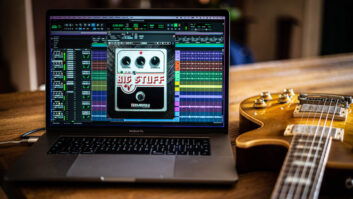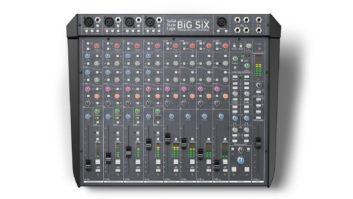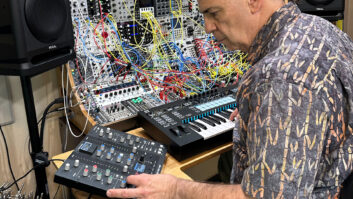“Bitstream” columnist Oliver Masciarotte once again scours his audio data dictionary to come up with another round of today’s top IT terms as they apply to the audio pro. Italicized words will be, or have been, defined in the glossary, some in upcoming issues.
Peripheral: When used in the IT sense as a noun, a peripheral means any additional device added to existing computer systems to improve functionality. Common peripherals are displays, printers, direct-attached storage and HUI products.
PEBKAC (Problem Exists Between Keyboard And Chair): aka, operator error. Also known as code 18 (operator error), which refers to the human entity screwing up, 18 inches from the display.
PHY: the physical transmission pathway in a network, usually “copper” (copper wire), glass “fiber” or POF. PHY often refers to the physical “layer,” or Layer 1, of the OSI Model.
Platform: oblique marketing-speak for the combination of software and, to a lesser degree, hardware, chosen for a product or service’s design. This catchall is usually used in reference to a CE product, such as the use of the Symbian “platform,” as opposed to Windows CE, for a converged PDA/cell phone.
POE (Power Over Ethernet): See 802.3af.
POF (Plastic Optical Fiber): In the world of fiber optics, the actual fiber strand can be manufactured from glass or plastic. Plastic fiber has poor internal reflection, as opposed to glass’ high efficiency in transmitting light from one end to the other. Though POF is very low-cost, this high loss results in much higher susceptibility to jitter and makes it suitable only for low data rate, short-haul connections. The AES Type 2 and 1394b standards both specify POF as a PHY media choice.
POTS (Plain Ol’ Telephone Service): Telephone service is based on a circuit-switched network over UTP.
PPC (PowerPC): a highly optimized RISC CPU design co-developed by IBM, Motorola and Apple Computer. Used by IBM in its more advanced server lines and by Apple in all of its computer products, the power architecture has remained a viable competitor to Intel’s 32-bit Pentium and 64-bit Itanium families.
Program: a file that instructs a computer to perform certain tasks. Programs are usually called applications.
Pseudo-stream, pseudo-streaming: the use of HTTP protocols and services for streaming rather than the more appropriate RTSP or UDP protocols and services.
PSTN (Public-Switched Telephone Network): the public circuit-switched telephone network, paid for in large part with our tax dollars, that originally carried POTS around the world.
QoS (Quality of Service): network performance metrics that include data loss rate and delay, aggregate throughput and packet priority. Usually implied to mean some guarantees that certain levels of performance are met.
QT (QuickTime): an ad hoc standard created by Apple Computer that provides a scalable, cross-platform wrapper for a wide variety of media data types. QuickTime has been incorporated into the MPEG-4 standard. QuickTime is a wrapper file format.
Rich Media: digital multimedia presentations that integrate streaming audio and video with images, text, hypertext or any other media type. SMIL is one method for delivering rich media.
RISC (Reduced Instruction Set Computer): As opposed to CISC computers, RISC architecture is only capable of a select or streamlined number of tasks, but they perform those select tasks with great alacrity. This is akin to BMW’s supercharged Mini against a normally aspirated Chevy Camaro. Intel and AMD sell more CISC CPUs, while Sun and IBM make RISC CPUs.
Router, to route: A router connects multiple nodes and directs packets from one node to one or more other nodes. The forwarding mechanism “looks” within each packet header for address data. A router specializes in exchanging packets between subnets. A TCP/IP router is a basic Layer 3 or network layer device that provides media-independent, dynamic packet forwarding.
RSTP (Real-time Streaming Protocol): an open standards-based protocol for streaming multimedia content to an RTP client. RTSP provides better isochronous delivery than UDP.
RTP (Real-time Transport Protocol): The RTP protocol, part of the next-generation IPv6 (IP Version 6) spec, provides end-to-end network transport functions suitable for applications transmitting real-time data over multicast or unicast network services. Real-time or isochronous data, such as audio, video or simulation data, requires uninterrupted, time-critical transmission. RTP data packaging, which usually flows over UTP, does not address resource reservation or QoS issues.
SAIT (Super AIT): See AIT.
SAN (Storage Area Network): collections of initiators, such as servers or individual “workstations,” and storage devices, typically disk- or tape-based, that are connected over a specialized or private LAN. The LAN can either have a copper or fiber PHY and usually employs either the ISCSI or FC protocols.
SAS (Serial-Attached SCSI): a fundamental change to the seemingly evergreen SCSI standard that defines a shielded serial connection in place of the unshielded parallel connection of prior versions. As with SATA, another protocol originally a parallel approach, SAS provides higher throughput and higher reliability with reduced form factor and a lower overall cost when compared to the parallel version.
SATA (Serial ATA): See ATA.
Scale, Scalable: In IT parlance, to scale means to change a system’s size, capacity or functionality. What is often implied is that the scaling can be done in a relatively easy or straightforward way, which is seldom the case.
SCSI (Small Computer Systems Interface): The SCSI standard defines a parallel and scalable interface that connects a peripheral, often storage devices, directly to a server or individual “workstation.” SCSI has largely been supplanted by other protocols such as ATA that are less costly or ones such as Fibre Channel that provide higher sustained throughput and availability. As one of the oldest computer protocols extant, SCSI is still keeping up with market demand by yet again updating the standard. The ratification of the Serial-Attached SCSI, or SAS standard, adds a new member to the already sizable SCSI family.
This column was written while under the hypnotic influence of my new Dyna-Flex gyroscopic exerciser and the addictive, slightly country grooves of The Cardigans’ Long Gone Before Daylight on Koch Records.
Show Me the (Virtual) Money Or, Is Digital as Good as Analog?
While writing this month’s column, I received a notice in my monthly bank statement. It informed me that, as of October 28, 2004, the Check Clearing for the 21st Century Act will take effect. As you may have received a similar insert, I thought it was a timely real-world case of information technology affecting your daily life. So, let’s take a look at what’s going on behind the scenes with your precious moolah.
My local Bank of the West, the North Beach area of San Francisco branch of a really great regional banking corporation, had begun the adoption of this paperless system. According to the insert, “…it is intended to improve the efficiency and reliability of the nation’s check payment system.” The act was signed into law on October 28, 2003, and, according to the Federal Reserve Board’s Website (www.federalreserve.gov), “…is designed to foster innovation in the payments system and to enhance its efficiency by reducing some of the legal impediments to check truncation.” Check truncation is the now-common practice of digitizing a check on its way to clearing so that the paper version can be retired and the electronic facsimile can be forwarded to the paying institution.
Check 21, as the law is known, facilitates check truncation by creating a new negotiable instrument called a substitute check, which, the Fed says, would permit banks to truncate the original, “…process check information electronically, and to deliver substitute checks to banks that want to continue receiving paper checks.” Though the law does not require banks to accept checks in electronic form nor does it require banks to use the new authority granted by the act to create substitute checks, it does codify that “…a substitute check would be the legal equivalent” of the original. In other words, the digitized version is just fine by us, thank you very much.
Bank of the West hopes that “Check 21 will reduce the time and cost of transporting billions of paper checks between banks. It will also reduce the vulnerability of the check payment systems to disruptions, such as extreme weather and natural disaster.” Or terrorist threats.
— OMas







